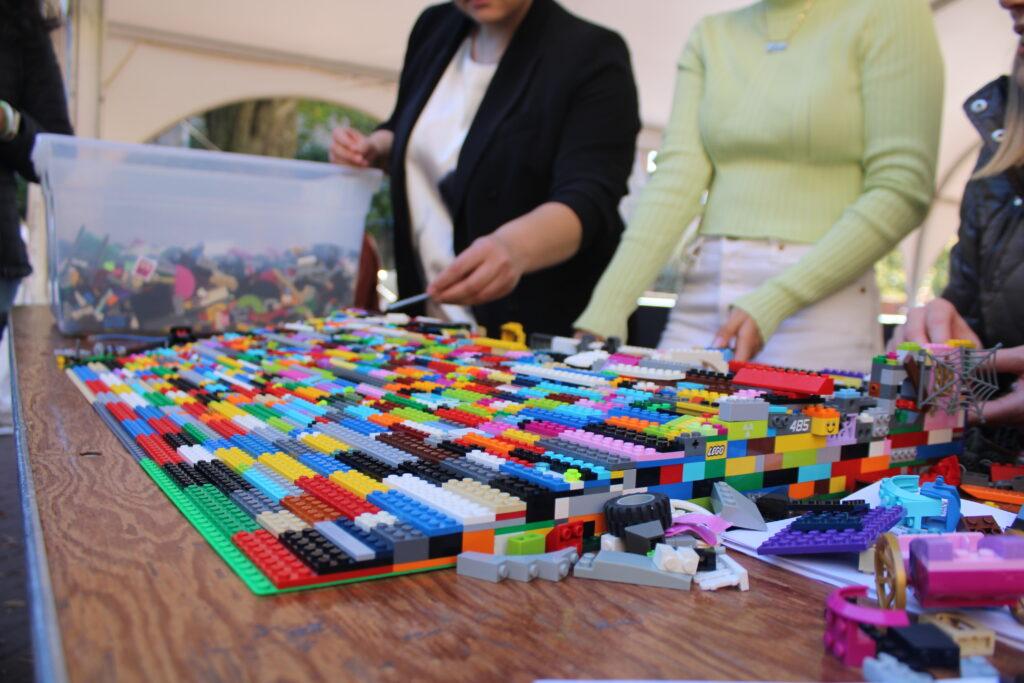The Disability Cultural Initiative (DCI) built a ramp out of legos during a two-day event in Red Square to promote accessibility on Georgetown University’s campus.
The event — titled “Ramping Up Access” — attracted more than 75 Georgetown students, faculty and staff to help construct the ramp, and was hosted Oct. 13 and 27. Many disability rights activists have built lego ramps in an effort to highlight the importance of inclusive and accessible spaces. The Ramping Up Access event aimed to show the Georgetown community that conversations about accessibility don’t always have to be difficult.
The event was meant to encourage community members to expand accessibility on campus whether that be by using ramps, alt text or Zoom captions in classrooms, according to Amy Kenny, associate director of the Disability Cultural Initiative.
“Building a ramp out of Legos invites everyone in the Georgetown community to participate in creating this culture of access, first by building a ramp, and then by implementing practical recommendations for expanding access in your classroom, club or office,” Kenny wrote in an email to The Hoya. “Plus, who doesn’t like Legos?”

The completed ramp was two feet deep, three feet wide and approximately the height of a stair. According to Kenny, the event was open to all students regardless of previous lego experience.
Briana Valle (COL ’23), the DCI’s student assistant, said one of the goals of the event was to get more people to learn about DCI’s resources and events in an original way. Near the lego ramp, DCI had little paper sheets printed out with instructions on how to make classrooms, offices and clubs on campus more accessible.
“We are trying to get more people to see our website,” Valle said. “We have a lot of resources, all of our events there. The main purpose was to call out accessibility, so it’s like a creative way to get people to want to stop by and play with legos, but in a way you’re still realizing ‘oh we need a ramp to call out accessibility.’”
Kenny said that the ramp often serves as a symbol of accessibility because it creates an inclusive space for people who use mobility devices such as wheelchairs and mobility scooters. However, she said accessibility extends beyond just ramps.
“It’s a practice, an ethos, a way of creating inclusive space that acknowledges that all of our body-minds have access needs and that we as a community get to meet those access needs as part of our commitment to cura personalis,” Kenny wrote.
Kenny said accessibility is often an “afterthought,” one that only comes up once a person with a disability advocates for their disability rights. Kenny hopes that the Georgetown community can come together and be more proactive in creating a culture of accessibility before issues arise.
“But we want to be a community that plans for accessibility from the beginning of every class, event and meeting so that disabled people with apparent and non apparent disabilities are able to thrive in our Georgetown community,” Kenny said. “Brick by Lego brick, we are building a more accessible world where our disabled classmates and colleagues get the opportunity to belong.”
Valle said DCI is still deciding where they will place the completed ramp, but it will cover one or two steps on a staircase.
According to Noah Martin (COL ’17, GRD ’19), the senior program designer for the Core Pathways Initiative who helped build the ramp at the event, there is an immediate need for ramps everywhere in Georgetown.
“You can just bring people in through something like play to do something that’s a little more visible and also a little more inclusive, bringing people in the conversation to talk about disability culture on campus,” Martin told The Hoya.
Dane Tedder (COL ’24), who learned about the event from his Disability and Culture anthropology class, said he decided to come and help build the ramp to engage with a community of students reflecting on accessibility.
“I came out to see a very visual example of community, and it’s definitely showing,” Tedder told The Hoya. “Seeing all the people around the table and all the people coming together, even in just that past 20 minutes I have been here, I think it’s just really powerful visually.”
Valle said support from the Georgetown community will help support DCI given its status as a new initiative that launched earlier this year.
“It’s very new,” Valle said. “I know there’s a lot of other organizations and clubs for disabilities but this one is really trying to take into consideration race, sexuality and the whole intersectional identity that people who are disabled come with.”




















